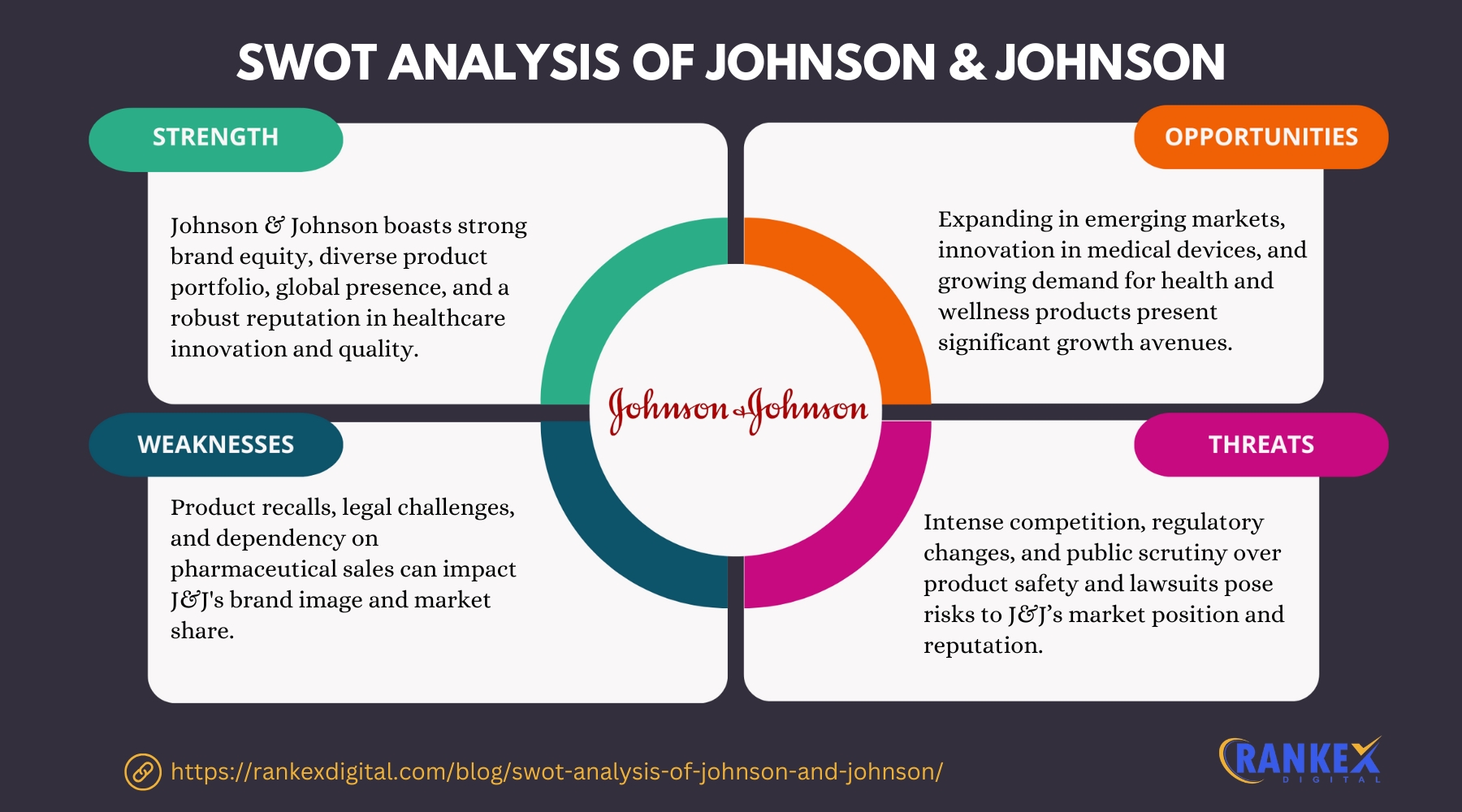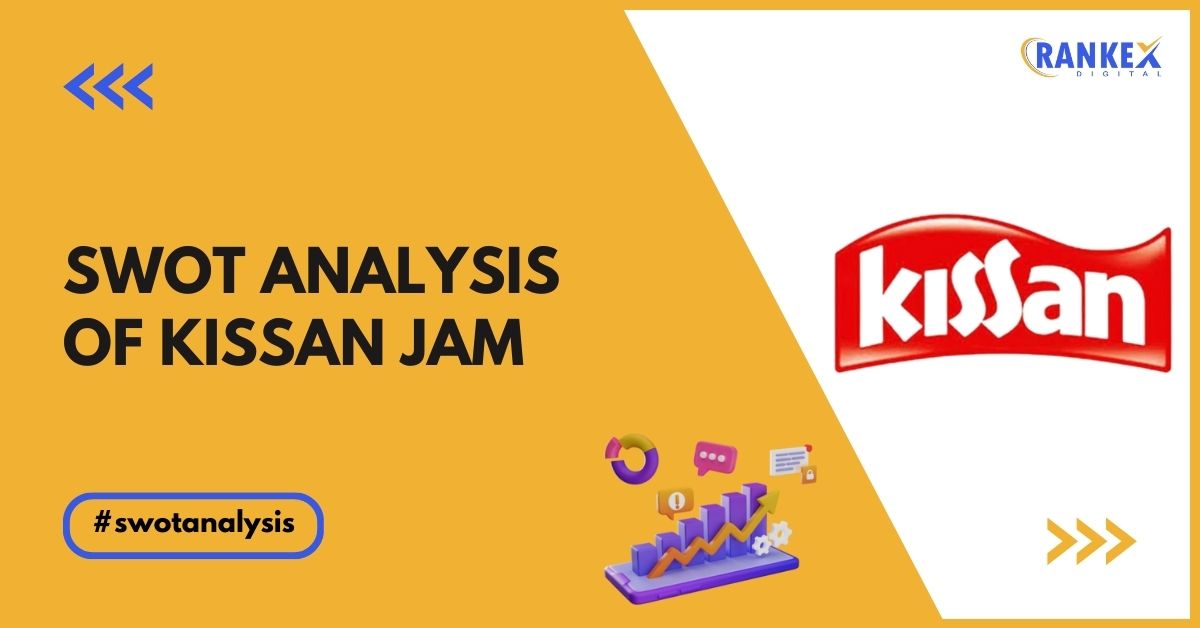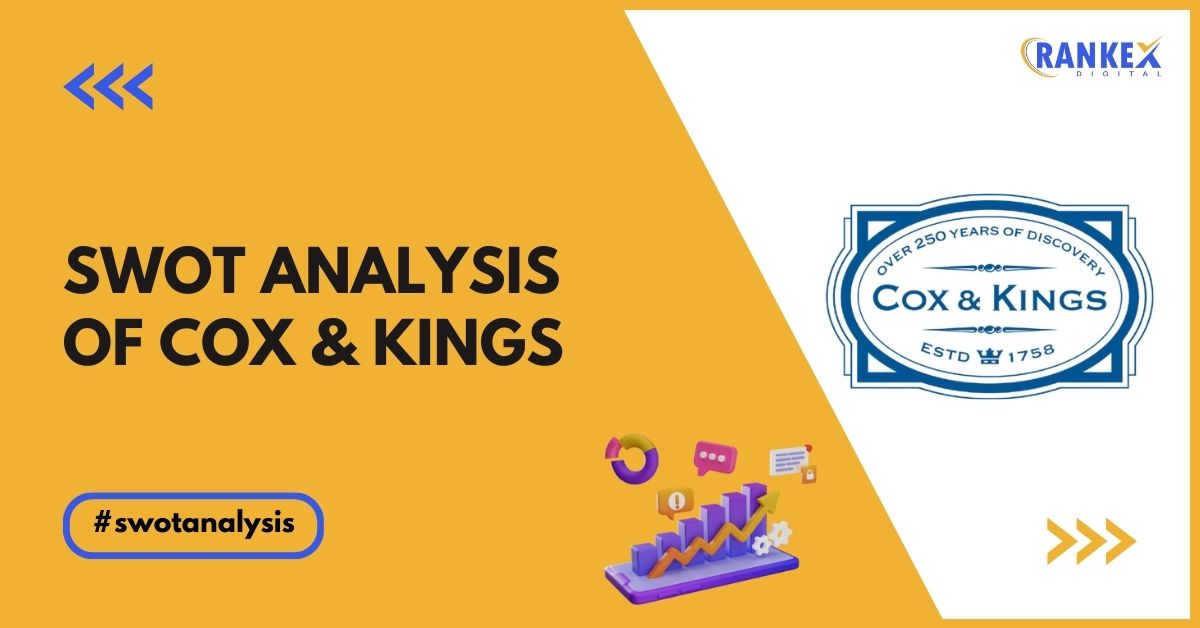Johnson & Johnson (J&J) is a global leader in the healthcare and consumer goods industry. With a presence in more than 60 countries and a product portfolio that spans medical devices, pharmaceuticals, and consumer health products, the company has made a significant impact on global healthcare over the past century. Established in 1886, J&J has grown into a diversified multinational corporation, known for its commitment to improving the health and well-being of people worldwide.
In this article, we will dive deep into the (Strengths, Weaknesses, Opportunities, and Threats) or SWOT analysis of Johnson and Johnson, offering insight into its current position and the strategies that could shape its future growth.
Table of Contents
Overview of Johnson & Johnson

Founded by Robert Wood Johnson I, James Wood Johnson, and Edward Mead Johnson in 1886, J&J is headquartered in New Brunswick, New Jersey. The company operates in three main segments: Pharmaceutical, Medical Devices, and Consumer Health.
Johnson & Johnson’s products include some of the most recognized global brands in healthcare, such as Tylenol, Neutrogena, Band-Aid, and Johnson’s Baby products. It is also a leading manufacturer of medical devices like orthopedic and surgical instruments, as well as a major player in the pharmaceutical market with drugs in oncology, immunology, and cardiovascular treatments.
Quick Stats About Johnson & Johnson
| Attribute | Details |
|---|---|
| Founder | Robert Wood Johnson I, James Wood Johnson, Edward Mead Johnson |
| Year Founded | 1886 |
| Origin | New Brunswick, New Jersey, USA |
| No. of Employees | 150,000+ |
| CEO | Joaquin Duato |
| Company Type | Public |
| Market Cap | $450 Billion |
| Annual Revenue | $95 Billion |
| Net Profit | $17.6 Billion |
Current News of Johnson & Johnson
- Vaccine Development: J&J has been at the forefront of global efforts to combat COVID-19, developing a vaccine that was widely used across the world.
- Environmental Sustainability: The company has committed to achieving carbon neutrality by 2030 and improving its environmental footprint in manufacturing and packaging.
- Healthcare Innovations: Johnson & Johnson continues to invest heavily in innovative healthcare solutions, focusing on improving patient outcomes through cutting-edge medical devices and pharmaceutical treatments.
SWOT Analysis of Johnson and Johnson

Strengths of Johnson & Johnson
- Diverse Product Portfolio
- J&J operates across three core segments: pharmaceuticals, medical devices, and consumer health products.
- This diversity allows the company to spread risks and maintain revenue streams even if one segment faces challenges.
- Examples include popular brands like Band-Aid, Tylenol, and Acuvue contact lenses.
- Strong Brand Recognition
- Iconic household names such as Neutrogena, Listerine, and Johnson’s Baby products have built global trust.
- The brand’s legacy and consistent product quality enhance its reputation and customer loyalty.
- Global Presence
- J&J operates in over 60 countries and markets its products in more than 175 countries.
- This extensive reach mitigates risks associated with regional economic downturns or geopolitical instability.
- Innovation in Healthcare
- With annual R&D investments exceeding $14 billion, J&J consistently develops groundbreaking medical solutions.
- Recent advancements include cancer therapies, advanced surgical tools, and vaccine development (e.g., COVID-19 vaccine).
- Strong Financial Position
- J&J has a history of stable revenue growth and profitability, with a AAA credit rating.
- This financial strength enables continuous reinvestment in innovation, acquisitions, and expansions.
Weaknesses of Johnson & Johnson
- Legal and Regulatory Challenges
- Ongoing legal issues, such as lawsuits related to talcum powder and opioids, have cost the company billions and impacted its reputation.
- Regulatory scrutiny often leads to lengthy litigation and settlements.
- Product Recalls
- Quality issues have occasionally led to product recalls, especially in medical devices.
- These incidents affect customer trust and incur financial losses.
- Dependence on the Pharmaceutical Segment
- Pharmaceuticals contribute over 55% of J&J’s revenue.
- Patent expirations and competition from generic drugs pose significant risks to this segment.
- Complex Supply Chain
- J&J’s global supply chain is vulnerable to disruptions from geopolitical events, pandemics, or natural disasters.
- The COVID-19 pandemic highlighted vulnerabilities in sourcing and distribution.
- Bureaucracy and Slow Decision-Making
- As a large multinational corporation, J&J’s complex organizational structure can delay decisions.
- This lack of agility might hinder the company in fast-evolving markets like digital health.
Opportunities for Johnson & Johnson
- Ageing Global Population
- The elderly population is growing rapidly, particularly in developed nations.
- This demographic creates an increasing demand for chronic disease management and advanced medical devices.
- Expansion in Emerging Markets
- Emerging economies like India, China, and Brazil represent significant growth opportunities due to rising healthcare awareness and income levels.
- Digital Health and Telemedicine
- J&J can explore digital health platforms, remote monitoring devices, and telemedicine solutions.
- These innovations can improve patient engagement and open new revenue streams.
- Strategic Partnerships and Acquisitions
- Collaborations with biotech firms and startups can accelerate innovation.
- Acquisitions, such as J&J’s purchase of Actelion Pharmaceuticals, bolster its product pipeline and market presence.
- Sustainability Initiatives
- Increasing consumer demand for eco-friendly products is an opportunity to focus on sustainability in packaging and operations.
- J&J’s existing sustainability efforts, like reducing carbon emissions, can be further expanded to align with global trends.
Threats to Johnson & Johnson
- Intense Competition
- J&J faces competition from pharmaceutical giants like Pfizer, Merck, and Novartis, as well as consumer health rivals like Procter & Gamble.
- The proliferation of generic drug manufacturers erodes revenue in key markets.
- Rising Healthcare Costs
- Governments and insurers are pressuring companies to reduce drug and medical device prices.
- Profit margins in the pharmaceutical segment may shrink as a result.
- Regulatory Scrutiny
- Strict healthcare regulations, particularly in the U.S. and EU, can delay product launches or result in costly compliance requirements.
- Price control measures and evolving health policies are significant risks.
- Economic Uncertainty
- Economic downturns may lead to reduced consumer spending on healthcare products, impacting sales across J&J’s portfolio.
- Cybersecurity Risks
- As digital health tools and patient data become integral, J&J faces heightened risks of cyberattacks and data breaches.
- Breaches could lead to reputational damage and regulatory penalties.
Top Competitors of Johnson & Johnson
- Pfizer
- Merck
- Bristol Myers Squibb
- AbbVie
- Procter & Gamble
Conclusion
Johnson & Johnson’s strengths lie in its diverse product portfolio, strong brand recognition, and innovative approach to healthcare.
However, the company faces challenges such as legal disputes, product recalls, and heavy reliance on its pharmaceutical division.
With opportunities for growth in emerging markets, digital health, and sustainability, J&J is well-positioned to maintain its leadership in the healthcare industry.
However, it must navigate external threats like intense competition, economic volatility, and regulatory hurdles to continue its legacy of success.
Frequently Asked Questions
- What are the main segments of Johnson & Johnson’s business?
Johnson & Johnson operates in three main segments: Pharmaceuticals, Medical Devices, and Consumer Health. - What are some of the popular products under Johnson & Johnson’s brand?
Popular products include Tylenol, Band-Aid, Neutrogena, and Johnson’s Baby products. - How does Johnson & Johnson contribute to healthcare innovation?
J&J invests heavily in R&D, particularly in the fields of oncology, immunology, and medical devices, driving healthcare innovations worldwide. - What are the biggest challenges Johnson & Johnson faces?
The company faces legal challenges, product recalls, intense competition, regulatory changes, and cybersecurity threats. - How does Johnson & Johnson plan to improve sustainability?
Johnson & Johnson has committed to achieving carbon neutrality by 2030 and is working on reducing its environmental impact through sustainable practices in its manufacturing and product offerings.











